Evaluating a smartwatch, from a regular watch-owner’s perspective
I’m somewhat of a watch fanboy. I have ~9 watches, one more is on preorder, and about half of them are from “indie” microbrands that conduct their projects on crowdfunding platforms like kickstarter. They also are priced at levels that, I suspect, most people would find absurd.. the average cost-per-watch in my ‘collection’ would be, in rough estimates, around $300 (a lot of those I chose because they were widely considered to be ‘good deals’, given the specs/quality/design – and this range is, interestingly enough, commonly considered “affordable” as far as watches go.. But let’s not delve into discussions on privilege, consumerism and so forth). That pricing is very, very close to what modern smartwatches seem to cost, give or take a hundred or so (and I’m sure that Apple’s Watch will stretch that price upwards quite a bit…).
So it is easy enough to think that smartwatches are ‘encroaching’ on the regular watch market – and, hey, a lot of them sure are marketed with a focus on how much like ‘normal watches’ they are (“Fine watch craftsmanship“, “A watch for our times“, “A timeless smartwatch” etc.). I got myself a smartwatch (Asus ‘ZenWatch’), and I have experience with ‘normal’ watches, so why not see how much like a watch the smartwatch actually is?
Now, let’s set the context parameters. 1) – I will be approaching this as a ‘watch’ evaluation, not as a technology showcase. 2) – I will focus on the same things I focus on when talking about normal watches. 3) – I won’t bother talking about software, unless in brief mentions. You can find all about Android Wear on, like, a thousand tech sites already. 4) – I do have a pro-watch bias. Obviously. I do also like gadgets, sure, and I did choose to pay for all this myself, but my preferences are firmly in the ‘normal watch’ category. (And maybe this post will help to show why that is..). 5) – I just received it. So I cannot give you any information on how it will hold together after 3, 4, 5 years.
There’s a few points that I want to go into with this, all (most) of them related to what could be termed “build quality”. As for whether you like the look of it – that’s up to you to decide, as everyone likes different things.
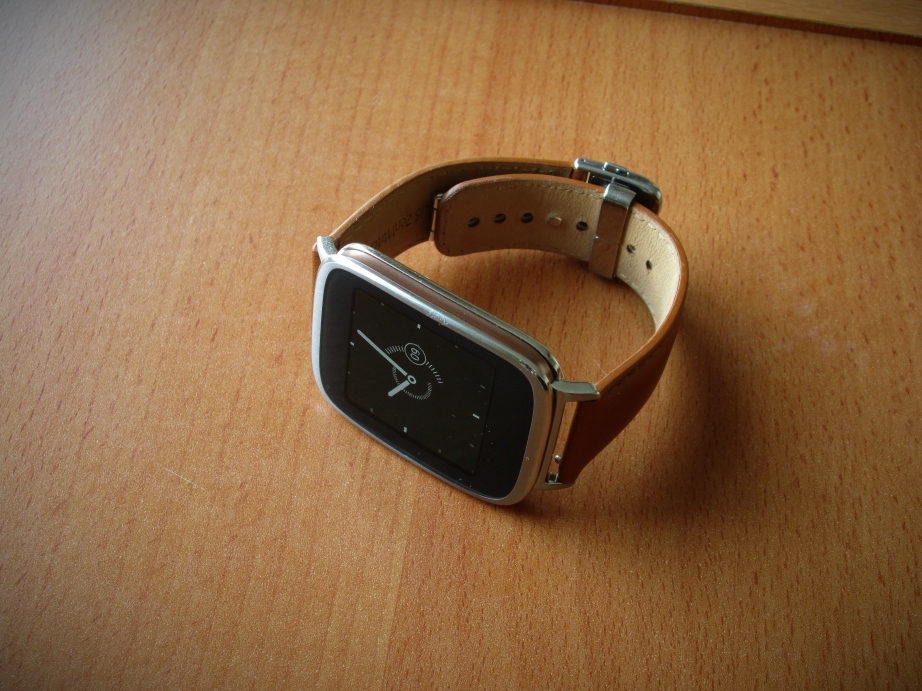
Asus ZenWatch up-close; stock strap, stock face, not worn more than a couple of hours. Pretty much as new and pristine as it’s ever going to be.
So, firstoff, let’s talk about how the ZenWatch case is made. Can I sum up with just two words? If I can, then those words are “Not quite”. Here’s the longer version:
It’s not a bad-looking thing. Heck, it’s not even a badly made thing, as far as I can tell; if this were a mobile phone, we’d be saying that it’s one of the better-made phones out there.
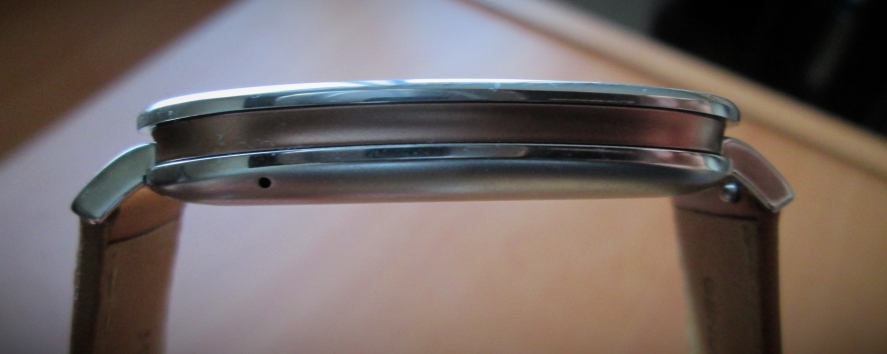
Side-view. Note that the caseback is actually fully flat. This is a bit of an annoyance, when it is also *that long*.
And yet. You can see in the pic above that there are very clear, very obvious gaps, assembly lines where different parts of the case are fitted together. Moreover, it’s visible that a lot of the form lines on the case are, well, indistinct. Rounded.
That’s not how a watch ought to be built. Allow me to post another example:
Note that where lines are meant to be sharp, they really are crisp and tight. Not so sharp as to cut anywhere – human skin is not *that* fragile, after all – but sharp enough to register as thin, non-rounded lines. That’s one way of estimating whether you are getting a good watch for the (frankly quite high) price or not – are the edges and lines finished with precision, or are they just stamped out without any further work?
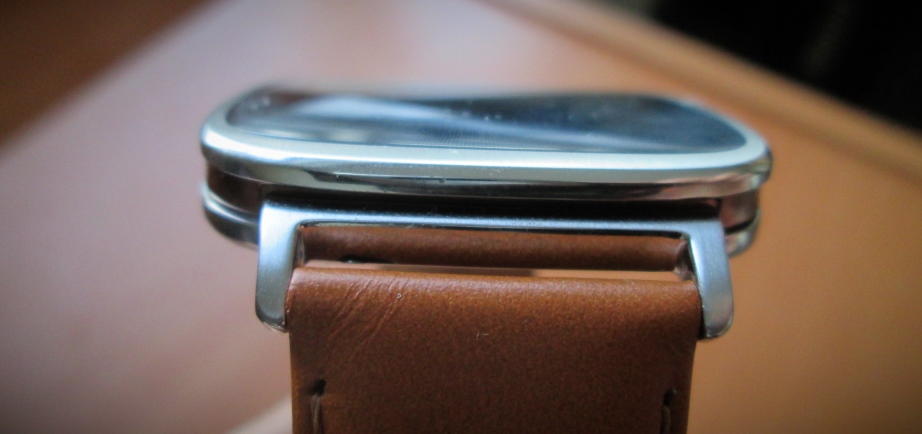
Another side-view. The top is slightly curved, though it looks like the actual display underneath is flat.
With regard to lugs (explanation: “lugs” are the sticky-out bits to which the strap is attached – usually via a spring-bar, a rolled metal pin with a spring in the middle that sticks into holes drilled into the lugs), well, the main thing that comes to mind is that they seem extremely tiny and fragile. Usually, when talking wristwatches, lugs are made from the same block as the watch case itself, here it seems they are a separate element (possibly because there is no single ‘case’ foundation to be seen – watches normally have a single, solid, strong piece of milled-out stainless steel, and lugs are part of that, not attached after-the-fact).

“Normal” lugs. Thicker, part of the case (and these are still comparatively sleek/small as far as watches go…
The glass on top, for this smartwatch (and for all others, excepting the more expensive editions of upcoming Apple Watch), is the industry-standard ‘Gorilla glass’. Sure, it’s an industry standard – when we’re talking about mobile devices. There is this scale of hardness, which can also be used to estimate scratch resistance – the Mohs scale. Short summary being, higher numbers scratch lower numbers, gorilla glass is about 6.5, quartz (and sand thingies) are 7, synthetic sapphire is 9, and only diamond is 10. Most wristwatches in this pricerange tend to use ‘glass’ made from synthetic sapphire – and that’s what you should ask for, and request; because those will not get any scratches from your keys, or bumps into doors, or when spending a summer constantly on beaches, or construction work (though red-hot sparks from steel cutting might still burn pits, so don’t do that to your watch). Basically – get a watch with sapphire window, forget about worrying whether it will scratch.
Gorilla glass.. well, I am sure all of you have smartphones, or have seen ones, and know that those displays still can (and often are) scratched by stuff like sand, keys, falls.. Aye, you can avoid them, if you are careful.. But putting a scratch-able glass window on a wrist-mounted device? Yeah, no, that’s not good enough. I’m certain that the tech industry will try to pull the ‘oh but it is too expensive’ thing, and Apple will use sapphire glass in only their higher-cost Watch versions. That’s BS. In ‘normal’ watches, you start seeing sapphire crystals – good ones, with anti-reflective coating and all – even at $100-$150 watches. The crystal itself, alone, does not cost more than ~20 bucks (and I’m sure that large companies have means of reducing the cost way below that).
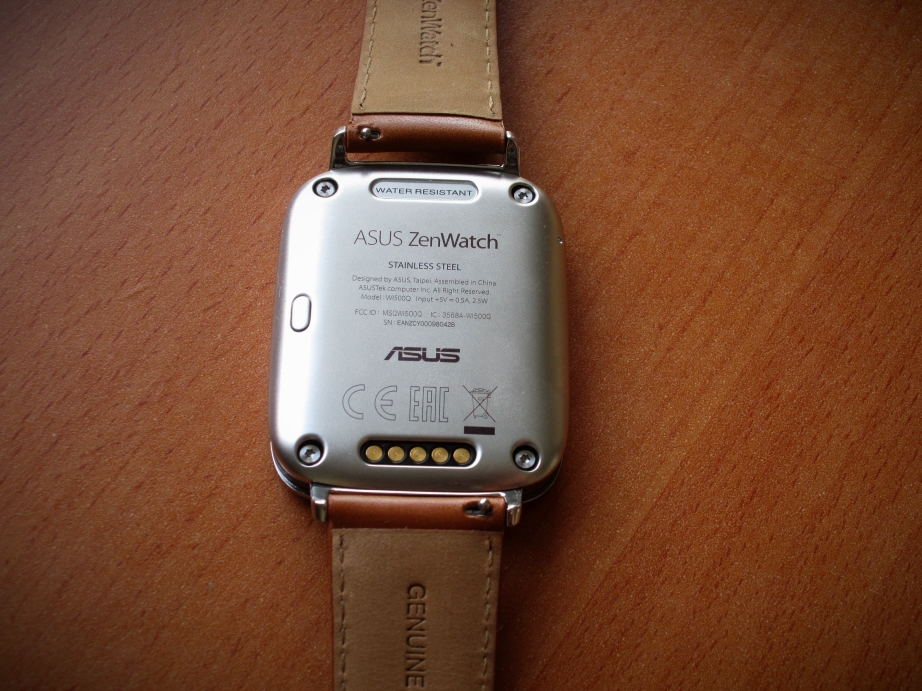
Caseback. The little nubs on the strap ends are ‘release’ pins, that allow you take the strap off without needing a special tool.
The caseback on this watch is, at least in my view, the most disappointing thing about the device. Firstly, note the exposed screw pits, the exposed charging connector, the large gap around the power button on the left edge… Moreover, it *feels* really thin and weak. Like it was stamped out of low-grade steel, at best… There is no excuse for the screw pits to be so large, deep, and with such bulky gaps around the screws. This is how a caseback with screws ought to be implemented:
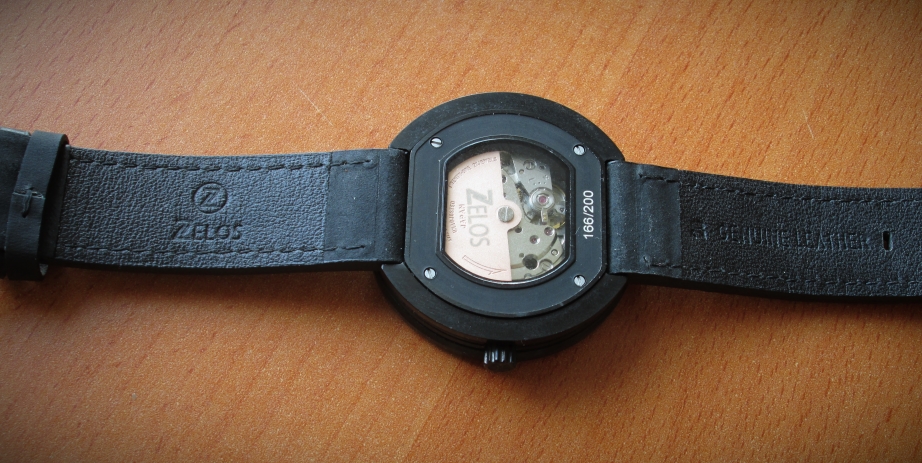
Minimal gap between screws and screw-holes. The use of flat heads is.. well, I’m ambivalent to it. Torx screwheads are kind of a tech industry standard, somost people can deal with those as well. Watches generally tend to use flat-edge screw heads.
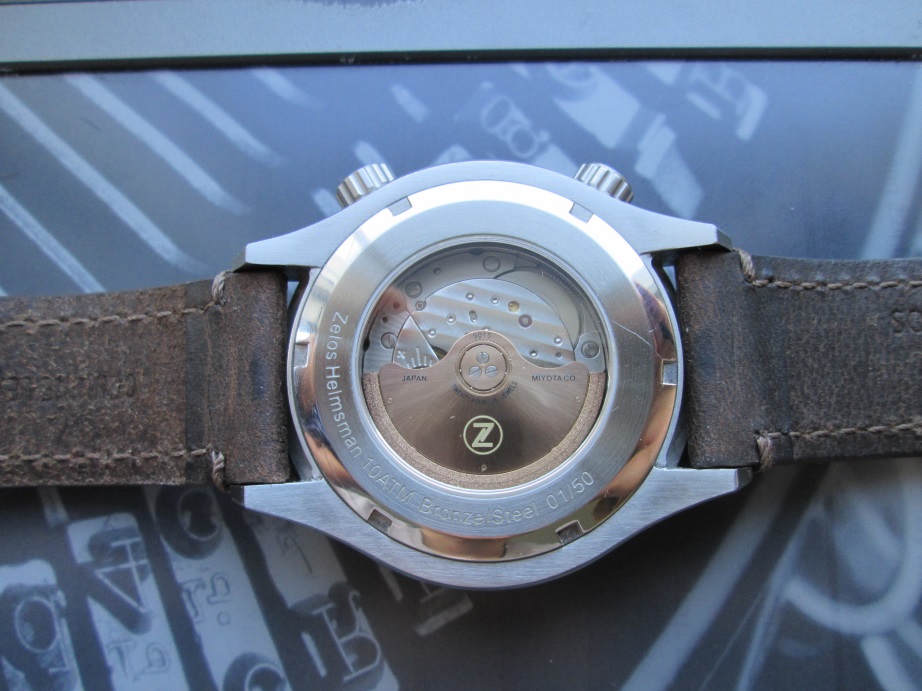
Here’s how screwed-in casebacks tend to look. No screws as such, as the back itself is a gigantic (if shallow) screw.
The ZenWatch’s caseback also claims that it is “water resistant”. Afaik all smartwatches have roughly the same level of water resistance, which I would generously describe as “sod all”. Don’t let the marketing terms fool you – these watches cannot really handle serious water. “Water resistant” is basically a marketing term – what it really means is that the item can handle light splashes, but cannot resist prolonged immersion, or any in-water activities such as swimming, diving, showering. On the one hand, I get that this is the modus operandi for smartphones.. On the other – A watch has to be sufficiently watertight to allow you to swim with it on. It’s not even a question of ‘why would you wear a watch while swimming?’, it’s a matter of just-in-case insurance. Smartwatches still have a lot of ground to gain in this aspect, and (imo) they really should switch away from the IPxx solid/liquid ingress standards, and onto the Water Resistance measurement standard that normal watches use (that specifies the amount of environment pressure that the watch can resist without breach – common ratings for watches are WR100 and WR200, which mean they could resist static water pressure equal to 100 meter and 200 meter depth.. And, yes, ‘static pressure’ is a bit of a wiggle term, and WR100 will not guarantee that the watch will remain fine if you actually dive to that depth, but in general terms, WR100 = fine to swim with and dive holding your breath, WR200 = fine to dive with, using scuba gear).
One final thing I want to mention wrt. the case materials: Most (good) watches, if they are made of steel, are using L316 steel – it’s considered to be a tough, scratch-resistant and corrosion-resistant variety that doesn’t bend or break easily. It’s also commonly used in surgical tools, and many watchmakers will advertise the material as “surgical grade steel”. It really doesn’t look or feel like Asus has used as high a grade in their case assembly… The feel of it – esp. the caseback and the top of the bezel – reminds me of a $30 casio I had years ago – which used low-grade, rolled steel sheets stamped into shape. I do hope smartwatches quickly grow out of using bottom-grade materials (and, tbh, maybe Apple’s offering will be the thing that finally pushes other companies out of their safe zone).
——————————————————————————–
Let’s talk about the design of the clasp, shall we?
Not great. Not great at all. The clasp is using completely flat metal strips, and there seems to be no second-stage safety beyond the spring-held push buttons on the clasp sides. No safety means that the clasp can easily snap open if the spring fails. More importantly, though – the flat metal sheets making up the clasp are prone to bending and breaking. Normally any clasps on regular watches (dirt-cheap ones aside) either use curve-stamped steel shape, or proper, thicker spars – to ensure that the clasp won’t break or bend in a couple of years of wearing… (and, in case you are wondering – it is relevant, I’ve managed to break a flat-stamped clasp like this apart as a kid.)
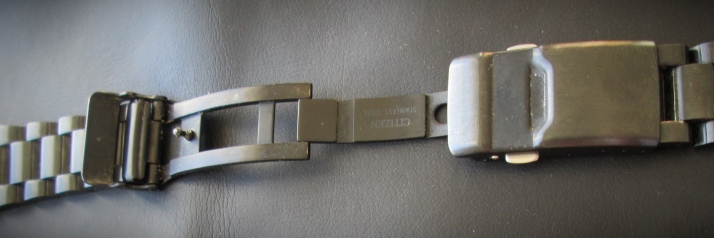
Thick spars in the foldy-together-bit, and a flip-over safety flap on top, in case the push-button lock opens up.
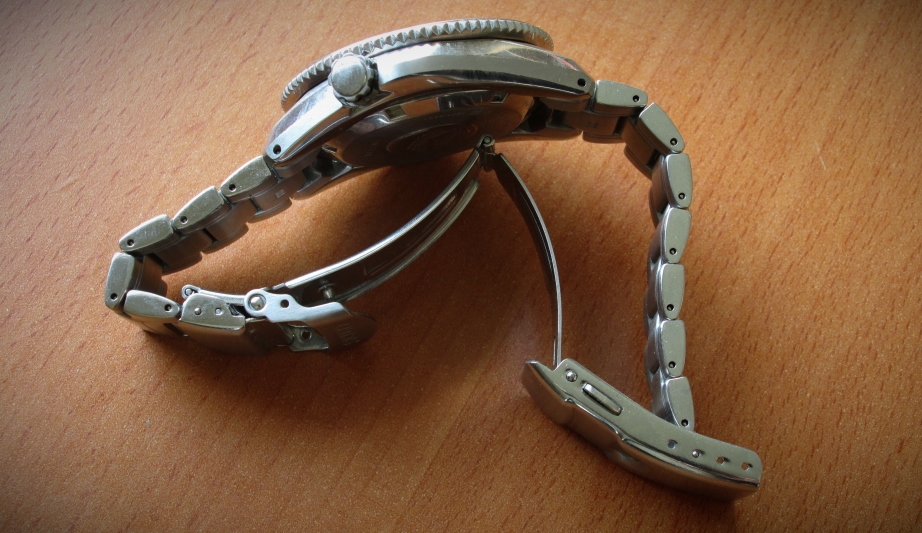
Curve-stamped clasp. Note how the steel folding-bits have reliefing to give additional rigidity. Even so, this is not considered a good solution, merely a borderline acceptable one. Sidenote: see how the watch case is curved to accommodate the wrist better.
There is also an issue with the thickness that Zenwatch’s clasp imposes. Or, to put it more precisely, the thick ‘step’ that it creates when in closed position.
That sort of step is just bound to catch onto ledges, clothing, whatever. Sure, most flip-lock clasps have to have some amount of thickness, simply due to the layers of steel involved, but the transition from the band to clasp should have a far lower profile / step.
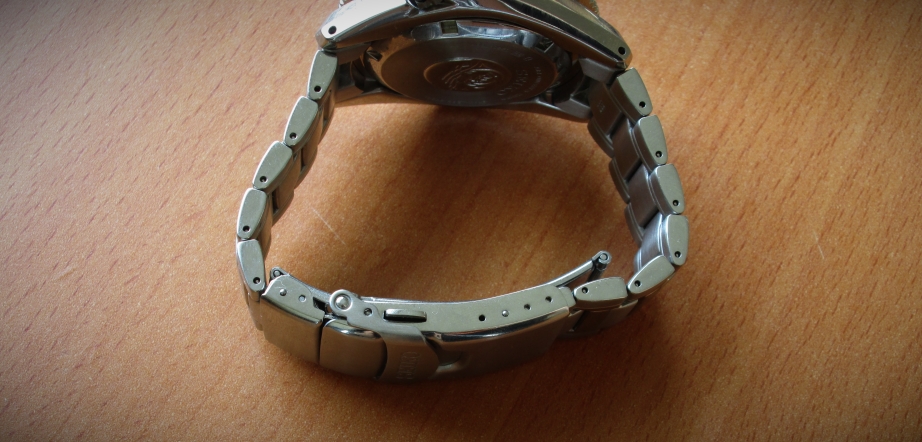
Closed clasp. Note how uniform the thickness is on the outer side – that will prevent if from catching on desk edges.
————————————————————
Another thing that tech websites seem to be oblivious about is the quality of the leather band that this smartwatch comes with.. The band is generally praised as being good-quality, well-made, and I just cannot help but wonder if the people writing those reviews have ever even handled a normal watch strap.
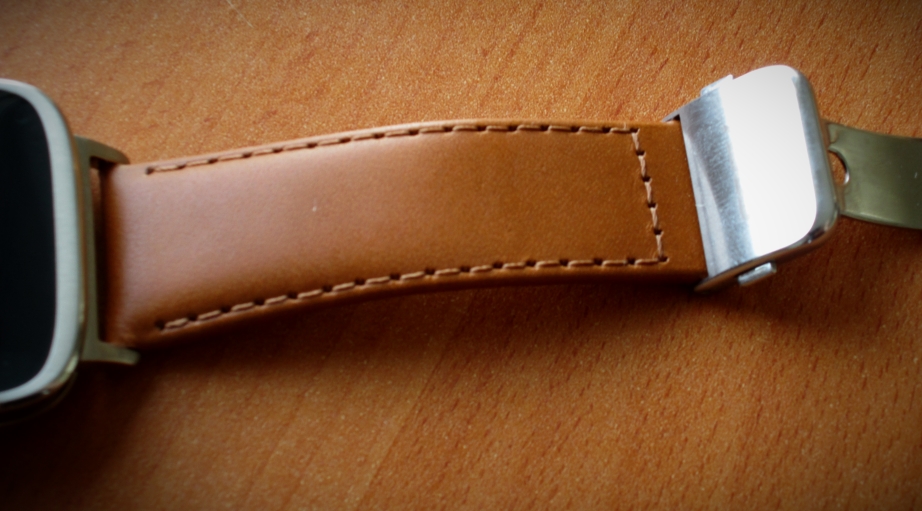
Lack of any ‘leather’ texture, thin stitching. Seems regular enough, though. (Also, why did they pick that colour?! Uuuuugh)
In ‘normal’ state, the strap seems decent enough – it is very thin, and quite stiff as well, but the real issue becomes apparent when you try to bend the strap outwards:
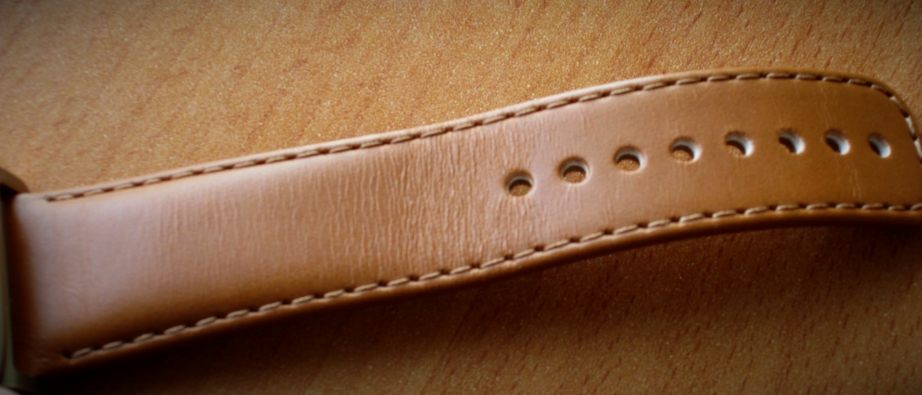
I hope that the hairline compression cracks are visible. Also, look at the holes, and you can see how thin the leather layer is, compared to the padding. Also, remember – this is instant result on a brand new strap, it’s not an outcome of months of wear.
That does not look like leather bending, that looks like a paint chipping on a painted surface. I seriously suspect that that’s exactly how this strap has been made – it doesn’t seem to be properly tanned, it seems to be a painted colour.. If it isn’t, then I really don’t know how they managed to ruin the material so much, for it to bend and mark like that. Here’s how a slightly more worn, ‘normal watch’ stock strap behaves:
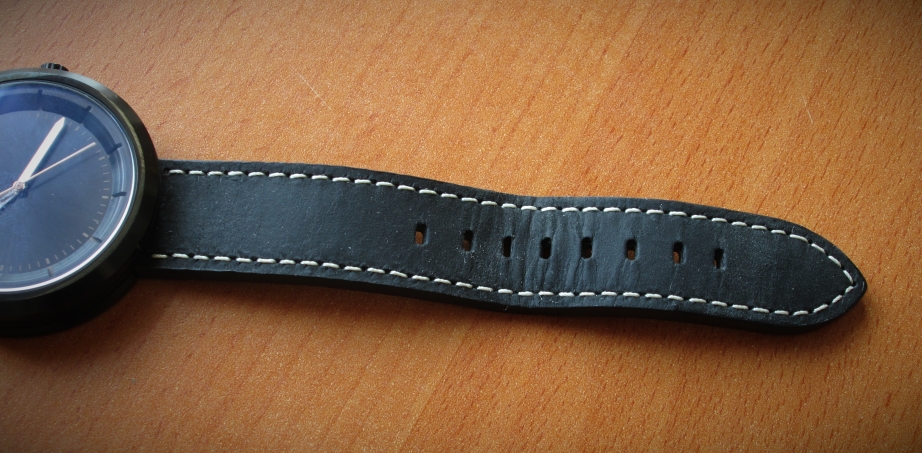
Larger ‘curves’. Also, note the thicker stitching. I cannot show it in pictures, but this is also far, far more pliant and soft.
But, even more importantly… the smartwatch strap on the Asus has no texture whatsoever. It feels and looks like leather in the same way that soft plastic feels and looks like leather – there is nothing to indicate that the material is what it claims to be.. On ‘normal’ watch straps, there is a very, very prominent use of natural (and, yes, sometimes stamped-in artificial) textures and patterns, and subtle colour shifts – all to create visual (and, more importantly, tactile) interest.
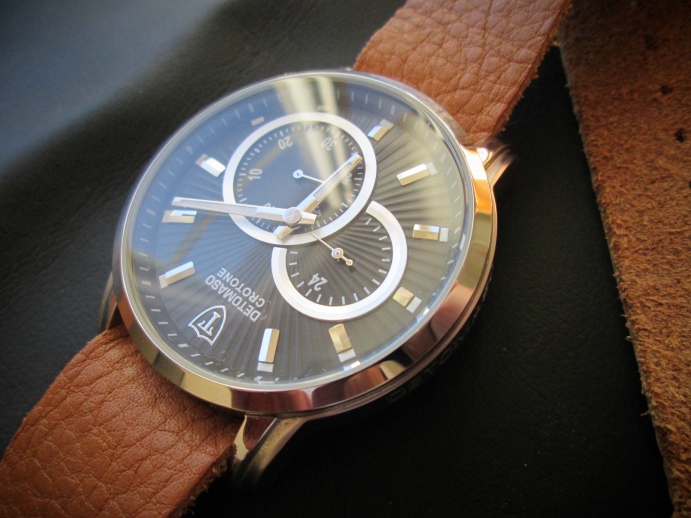
Single-piece, single-layer, non-padded strap. very basic natural texture and feel. I think it was veg-tanned. Something like $10.
And, well, if you are not okay with leather being used for watch straps, for whatever reason – I understand. There’s plenty of options for using metal links, there’s synthetic materials, there’s various kinds of rubber/polymer materials, there’s canvas straps… Thing is, Asus didn’t choose to use those. It went with ‘genuine leather’, and it chose to make that a big selling point (and, I think, Motorola also advertises the 360’s strap as leather, right? Oh gods.. having seen it, that’s an even lower-quality strap). Hence, me remarking that, no, it’s nowhere near high-quality, and Asus (and all smartwatch manufacturers so far, it seems) should really be called out on their marketing exaggerations.
The upside, then, is in that the lugs on this smartwatch are standard, so changing the strap to whatever else is simple, and there’s a million better after-market options available from an already established market. When (if) you consider getting a smartwatch for yourself – do make note on whether it uses standard strap attachments (i.e. lugs, springbar-through-strap, common strap widths are 18, 20, 22mm) or a proprietary solution (like what Apple will do on their Watch).
—————————————————————————————————–
One thing about the styling I did want to mention: egads, this thing is tall! Possibly too tall, in fact.
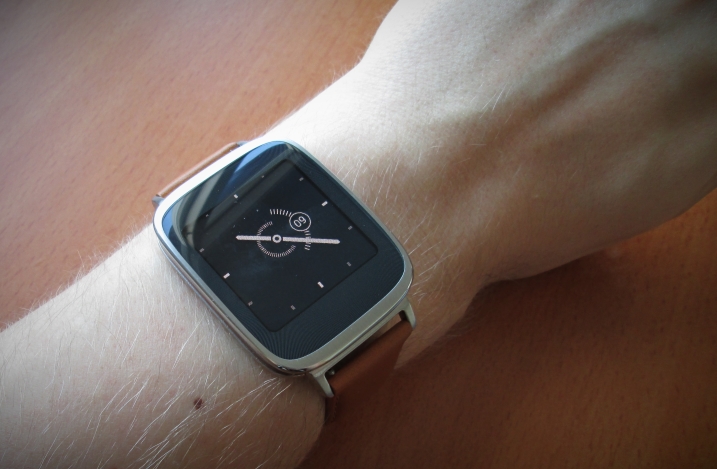
Because the caseback is not curved, it kinda balances like a see-saw on the wrist. The axis where the strap attaches to the case is significantly above the skin.
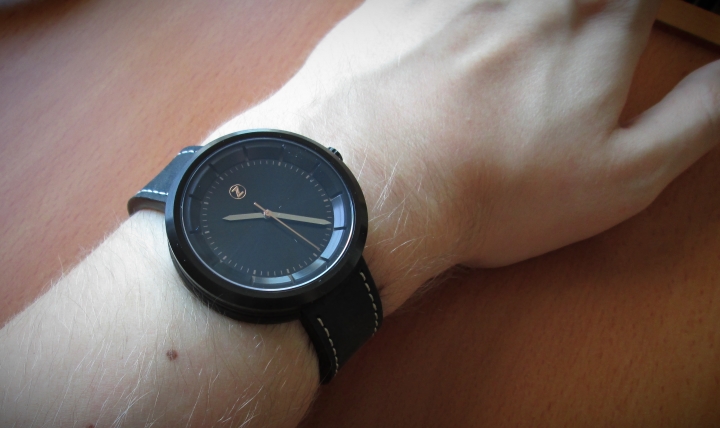
In comparison, here the strap is flush with the arm all the way around. Most watches come close to this sort of feel, and it’s far more comfortable. Watches with large lugs tend to make them curve down to fit wrist contours better.
————————————————————————————————————————–
So where does all this leave us.. Should I conclude by saying that smartwatches are junk? Or maybe that smartwatches are nothing like watches and should instead be judged as smartphones?
Well… No and no, I think. Sure, the companies making these first-generation wrist computers are getting a lot of stuff wrong, and more importantly, the people ostensibly reviewing them – gadget fans and tech dudes – just don’t have the context/knowledge to expect any better, it seems. In time, I expect that the quality and comfort will improve. And – as long as they are meant to be worn in the place of watches, are shaped kinda like watches, and are marketed as ‘smart watches’, they are (imo) fair game to being criticized as such.
There is one thing that does bother me, and it’s obsolescence. We all know how fast mobile technology moves on – two years, and a top-end smartphone is considered ‘old’, and the software is woefully out of date. Four years, and your average phone or tablet is dinged and scratched, and slow, and no longer supported at all, and if something breaks, good luck fixing it… And same goes with smartwatches – they are not, and have never been intended to be, long-lasting products. And yet, “normal” watches are the exact opposite – you pay for it once, and then you wear it for five, ten, twenty, fifty years. Maybe take it to be serviced by a watchmaker once in a decade, if you have a fancy watch. And even after all that time – it is not a curiosity, it is not an outdated relic, it is still a wristwatch and it still works. The “technology” used in modern wristwatches – high grade steel, sapphire crystals, synthetic rubies for gear axis mounts, shock-resistant movements – all that only increases their durability. Remember how I said that on average the watches I had cost me ~$300? In the context of them being good to wear for 10, 20 + years, that seems acceptable. I don’t know if a smartwatch, with an average lifespan of a year or two, for nearly the same amount of money, is as easy to justify. And yet… This seems far more likely to be the “next big thing” for the vast majority of people than, say, Google Glass or Oculus Rift.
I do want smartwatches to improve. I want them to be better-built, and to find a way to remain relevant for more than just 2-3 years per model. I want to be able to not worry about scratches, about clasps breaking, about water damaging the thing, and I want to be able to get it and just oggle how it looks and is proportioned, and not feel like it has been a waste of not-insignificant amounts of money.
So far.. ‘normal’ watches provide that. Smartwatches, as of now, still have not managed to crack it. Not quite.
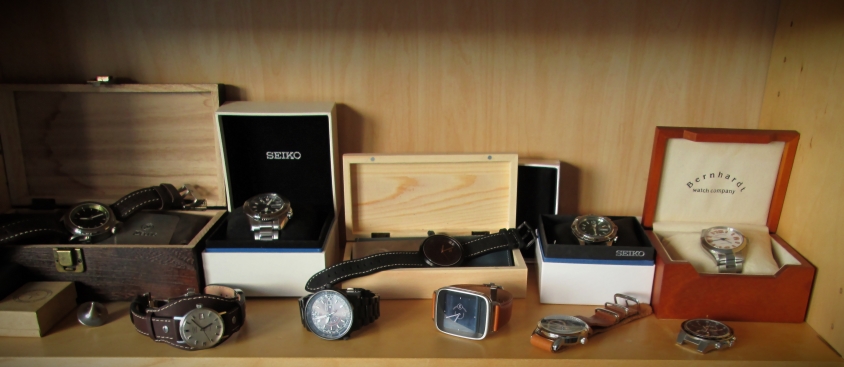
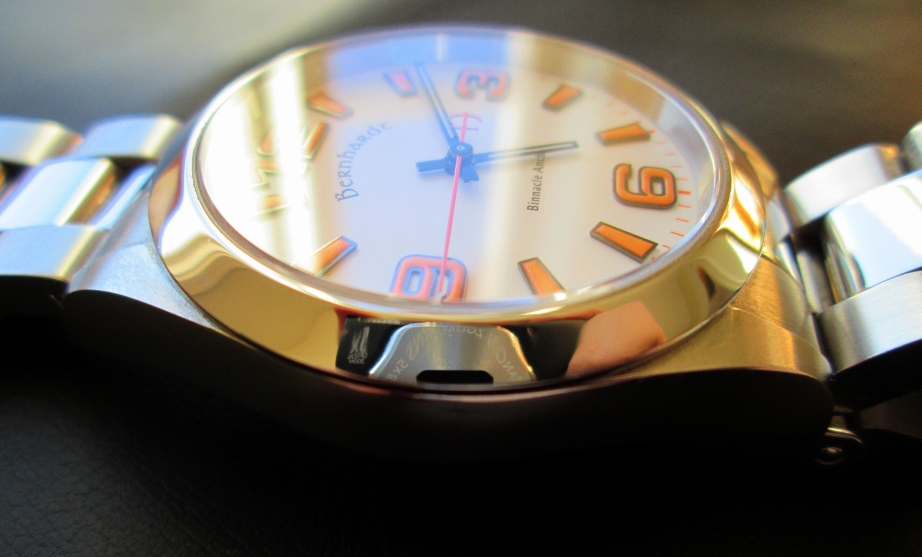
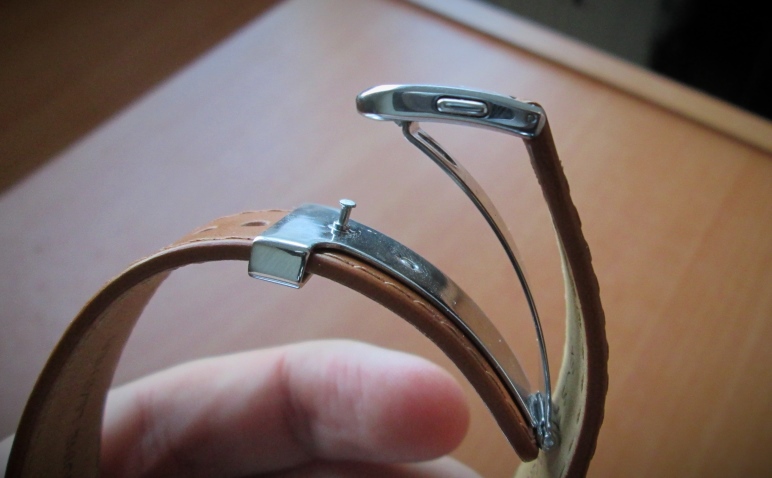
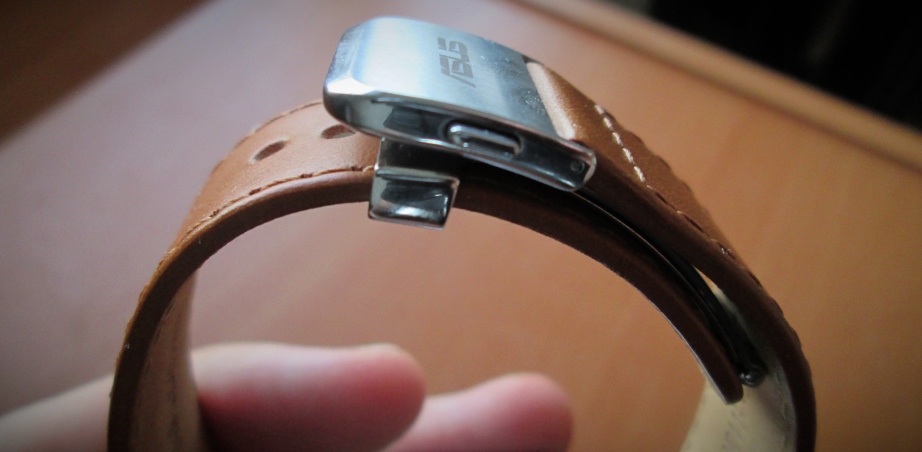
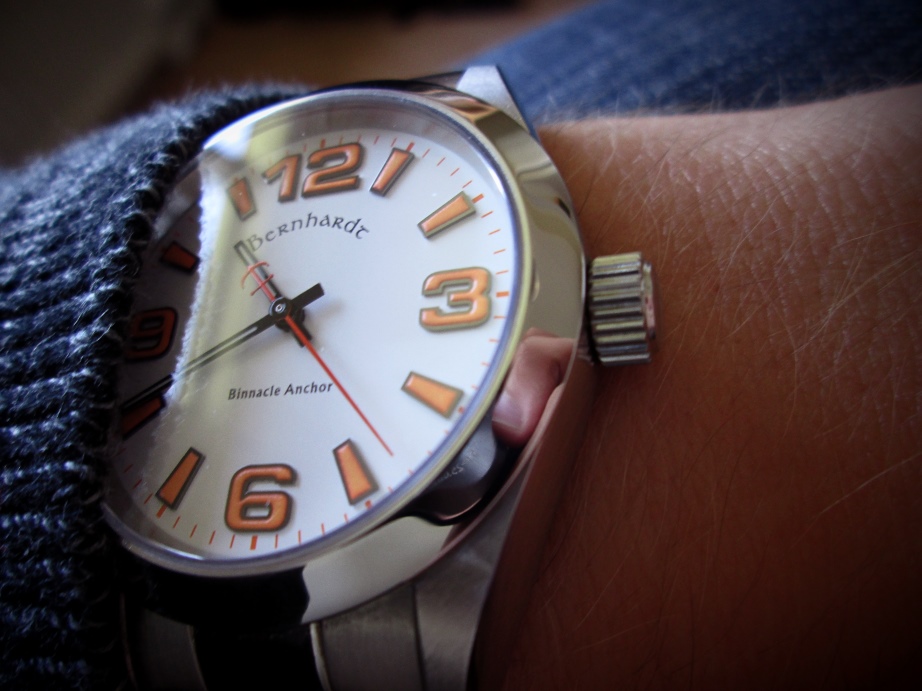
Hey interesting article. I’ve never looked at watches so closely before. I’m curious what you think of the Samsung Galaxy gear S. It contours much more to your arm and it has a very secure clasp. Its also less chunky than the Zenwatch.
27/07/2015 at 18:01
Hm. Several issues with that one, imo:
– lack of android wear. You’re locked into samsung’s proprietary environment, which limits your options in terms of watch apps, mobile-app compatibility, and more importantly, there won’t be any real life expectancy for this. Samsung will drop this the moment they make a few new models, and the OS almost assuredly will *not* be updated on your watch.
– More importantly: it’s still a 1st generation smartwatch. The screen is still low-res, the batteries still last just a day at most, and samsung still isn’t sure what a smartwatch would be good for. Tbh at this point, I recommend one thing to everyone asking abt smartwatches – wait for the next generation of them. Other manufacturers will take Apple’s watch results into account, and adjust their own devices for the better. Battery life *needs* to improve, too, as does charging-speed, screen-on timing and wake-up, and overall use-case.
just as a sidenote, I’ve sold the zenwatch off by now. Ultimately it was just too unnecessary/useless for my daily life, and it visually does not look good enough to be an ornament. At this point, I think you can get the benefits of a smartwatch, all that tracking stuff, by wearing a sports wristband with sensors instead – you’ll get better accuracy and it won’t look nearly as gaudy.
30/07/2015 at 20:56
Hey there
Some of your points are indeed valid. Tizen has a pathetic app selection and if id known how poor it was i woudl ahev thouight twixce about buying the watch perhaps. That said, the Gear S is a stand alone phone since it has a sim card slot, the only smart watch that does so and thus the only smart watch that can work completely independently from a phone. You do need your phone to install apps however, but it is otherwesie standalone.
The sim card slot means I can go out without my phone and receive calls, browse the net and use GPS mapping wherever i am which is very useful indeed especially if I’m doing something like biking where I’d be concerned about my phone falling or otherwise being damaged. having a watch on my wrist with MP3s, mapping and calling functionality as well as speech recognition so I can be like “answer”without stopping is very useful.
I find it interesting you cite apple as a market leader when their watch is light years behind Samsung, doesn’t contour as neatly, has a smaller lower res screen and most importantly needs your iPhone right there to do anything at all. I think my Gear S is useful as it is and while it is doubtless a 1st gen device still (Despite being the forth model in the series) I feel you shouldn’t write off smartwatches. they have a ton of potential and the Gear s is the most advanced one yet. I think you should try out an S. Does a sim card slot and completely phone free operation not appeal to you?
As for no OS updates, I’ve had an OS update already and I’ve only owned the watch for a month. Rhe Gear manager on my phone also updated. the upcoming Gear A will also be Tizen, so I don’t expect the OS to be abandoned.
I disagree about the battery. Under normal use I get more than a day it depends on what I’m doing with it. the only thing that kills battery is youtube. that drain it in an hour or two if I have the bigrhtness up. The battery should be better, but a day at most is incorrect.
I also disagree about the Gear s looking gaudy. it is essentially a smaller,curved Samsung Galaxy and is thus very sleek and easy on the eyes. I would like a leather or metal strap however. the normal strap is plain but it breathes very well I never get any sweatiness like you often get with watches. It also fits very snugly and doesn’t slide up my arm I think it looks very Star Trekish. I love the slight chunky but still sleek look. the Zen did look pretty bad in your post but that is an old watch now they aren’t as chunky as that anymore. I also find it ironic you talk about extremely expensive large metal watches and refer to the Gear s or Zen as gaudy. Traditional watches with their gold and diamonds are far more gaudy than any smartwatch in my opinion. Of course the ridiculously expensive and limited Apple watch is an exception to this. if you wear an apple watch you’re pretty much broadcasting you have more money than sense.
30/07/2015 at 21:20
Oh Armok the typos!
30/07/2015 at 21:27
Also see here the watch contours and thr clasp lies nearly flat. Sammy learned from asus it seems
01/08/2015 at 08:55